#indigenous farming
Text
Wow imagine if your city had a public food forest. Just a plot the size of a standard park. But full of free edible foliage.
"you want crepes for dinner? Okay well stop at the food forrest on the way home and see what fruits we can forage." 😩
#and it would probably be cheaper to maintain than your cities municple golf course#food forrest#sustainable farming#indigenous farming#stewards of the land#food#local government
1 note
·
View note
Text
"In response to last year’s record-breaking heat due to El Niño and impacts from climate change, Indigenous Zenù farmers in Colombia are trying to revive the cultivation of traditional climate-resilient seeds and agroecology systems.
One traditional farming system combines farming with fishing: locals fish during the rainy season when water levels are high, and farm during the dry season on the fertile soils left by the receding water.
Locals and ecologists say conflicts over land with surrounding plantation owners, cattle ranchers and mines are also worsening the impacts of the climate crisis.
To protect their land, the Zenù reserve, which is today surrounded by monoculture plantations, was in 2005 declared the first Colombian territory free from GMOs.
...
In the Zenù reserve, issues with the weather, climate or soil are spread by word of mouth between farmers, or on La Positiva 103.0, a community agroecology radio station. And what’s been on every farmer’s mind is last year’s record-breaking heat and droughts. Both of these were charged by the twin impacts of climate change and a newly developing El Niño, a naturally occurring warmer period that last occurred here in 2016, say climate scientists.
Experts from Colombia’s Institute of Hydrology, Meteorology and Environmental Studies say the impacts of El Niño will be felt in Colombia until April 2024, adding to farmers’ concerns. Other scientists forecast June to August may be even hotter than 2023, and the next five years could be the hottest on record. On Jan. 24, President Gustavo Petro said he will declare wildfires a natural disaster, following an increase in forest fires that scientists attribute to the effects of El Niño.
In the face of these changes, Zenù farmers are trying to revive traditional agricultural practices like ancestral seed conservation and a unique agroecology system.
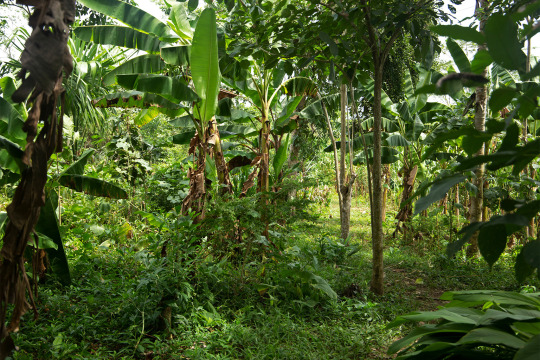
Pictured: Remberto Gil’s house is surrounded by an agroforestry system where turkeys and other animals graze under fruit trees such as maracuyá (Passiflora edulis), papaya (Carica papaya) and banana (Musa acuminata colla). Medicinal herbs like toronjil (Melissa officinalis) and tres bolas (Leonotis nepetifolia), and bushes like ají (Capsicum baccatum), yam and frijol diablito (beans) are part of the undergrowth. Image by Monica Pelliccia for Mongabay.
“Climate change is scary due to the possibility of food scarcity,” says Rodrigo Hernandez, a local authority with the Santa Isabel community. “Our ancestral seeds offer a solution as more resistant to climate change.”
Based on their experience, farmers say their ancestral seed varieties are more resistant to high temperatures compared to the imported varieties and cultivars they currently use. These ancestral varieties have adapted to the region’s ecosystem and require less water, they tell Mongabay. According to a report by local organization Grupo Semillas and development foundation SWISSAID, indigenous corn varieties like blaquito are more resistant to the heat, cariaco tolerates drought easily, and negrito is very resistant to high temperatures.
The Zenù diet still incorporates the traditional diversity of seeds, plant varieties and animals they consume, though they too are threatened by climate change: from fish recipes made from bocachico (Prochilodus magdalenae), and reptiles like the babilla or spectacled caiman (Caiman crocodilus), to different corn varieties to prepare arepas (cornmeal cakes), liquor, cheeses and soups.
“The most important challenge we have now is to save ancient species and involve new generations in ancestral practice,” says Sonia Rocha Marquez, a professor of social sciences at Sinù University in the city of Montería.
...[Despite] land scarcity, Negrete says communities are developing important projects to protect their traditional food systems. Farmers and seed custodians, like Gil, are working with the Association of Organic Agriculture and Livestock Producers (ASPROAL) and their Communitarian Seed House (Casa Comunitaria de Semillas Criollas y Nativas)...
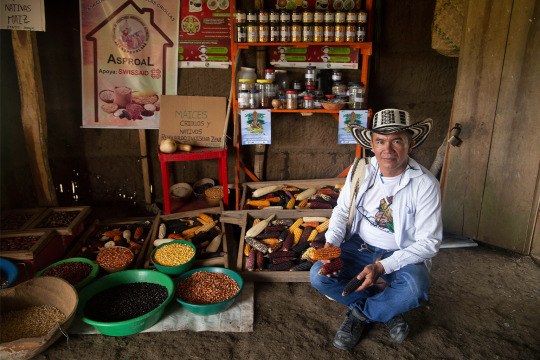
Pictured: Remberto Gil is a seed guardian and farmer who works at the Communitarian Seed House, where the ASPROL association stores 32 seeds of rare or almost extinct species. Image by Monica Pelliccia for Mongabay.
Located near Gil’s house, the seed bank hosts a rainbow of 12 corn varieties, from glistening black to blue to light pink to purple and even white. There are also jars of seeds for local varieties of beans, eggplants, pumpkins and aromatic herbs, some stored in refrigerators. All are ancient varieties shared between local families.
Outside the seed bank is a terrace where chickens and turkeys graze under an agroforestry system for farmers to emulate: local varieties of passion fruit, papaya and banana trees grow above bushes of ají peppers and beans. Traditional medicinal herbs like toronjil or lemon balm (Melissa officinalis) form part of the undergrowth.
Today, 25 families are involved in sharing, storing and commercializing the seeds of 32 rare or almost-extinct varieties.
“When I was a kid, my father brought me to the farm to participate in recovering the land,” says Nilvadys Arrieta, 56, a farmer member of ASPROAL. “Now, I still act with the same collective thinking that moves what we are doing.”
“Working together helps us to save, share more seeds, and sell at fair price [while] avoiding intermediaries and increasing families’ incomes,” Gil says. “Last year, we sold 8 million seeds to organic restaurants in Bogotà and Medellín.”
So far, the 80% of the farmers families living in the Zenù reserve participate in both the agroecology and seed revival projects, he adds."
-via Mongabay, February 6, 2024
#indigenous#ecology#agroforestry#agriculture#traditional food systems#traditional medicine#sustainable agriculture#zenu#indigenous peoples#farming#colombia#indigenous land#traditional knowledge#seeds#corn#sustainability#botany#plant biology#good news#hope#climate action#climate change#climate resilience#agroecology#food sovereignty
1K notes
·
View notes
Text
so I found this really cool website that sells native seeds- and you might be asking me "snekdood, haven't you posted an entire list of websites that sell native wildflower seeds that you're going to add on to soon?" and yes that's true, but that's not the kind of native seed im talking about rn.
see, on my quest to find websites that sell native wildflowers, I came across this dope ass website that sells seeds that have been farmed and harvested by ntv people traditionally, i'll let the website do the talking:




so anyways this is the coolest website ever. you can find the wild relatives of chiles on here called chiltepines, you can find different colors of corn and cool squash's, and every seed from whichever farm has it's own lil origin story written about it. you can also find other veggies here that are already commercially available to help fund and support this organization. as well as there being a cool gift shop with a lot of art made by different native folk from all around as well as cookbooks, jewelry, pottery, weavings, and clearly plenty more:

as well as a pantry?? with premade soup mixes??? and i really want to try them now??????
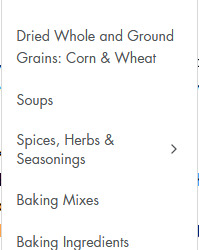
anyways I think its worth snoopin' around bc I'm almost positive you'll see something you think is cool (oh also if you happen to have some seeds passed down from ur family too and ur also native they seem like they would gladly help produce more)
#heirloom seeds#native plants#native wildflowers#native seeds#native seeds search#gardening#farming#seed conservation#heirloom vegetables#vegetables#crops#food#native american#native american traditions#native american heirloom seeds#support indigenous people#indigenous art
2K notes
·
View notes
Text
On the border of Peru and Bolivia, the Waru Waru—an indigenous Quechua word that means ridge—are once again protecting potato and quinoa crops as they did in the region 2,000 years ago.
"It is an agricultural system that lets us face climate change, which has changed the seasons of the year. It is very beneficial in times of drought and frost," farmer Cesar Cutipa, 42, told AFP.
Puno lies on Lake Titicaca about 3,812 meters (12,507 feet) above sea level. Farmers have made six Waru Waru nearby in flood-prone fields.
Furrows form a rectangular platform, where planting is done. Surrounded by water, the planting beds are up to 100 meters long, between four and 10 meters wide and one meter high.
The water around the plants creates a microclimate, absorbing heat from the sun during the day and radiating it back at night to ward off frost in sub-zero temperatures.
"The Waru Waru cannot flood during the rainy season because they have an intelligent drainage system that reaches the river. They have many advantages," agronomist Gaston Quispe told AFP.
In 2023, when Puno suffered one of the largest periods of drought in almost six decades, Waru Waru helped farmers cope with lack of water and avoid food shortages.
The area is home to mostly indigenous farming communities, mostly Quechua in Peru—and up the Andes—and both Quechua and Aymara in Bolivia.
"We are able to live here peacefully because we have our potatoes, our quinoa and barley. We can be in peace without going to the city," said 22-year-old farmer Valeria Nahua.
183 notes
·
View notes
Text

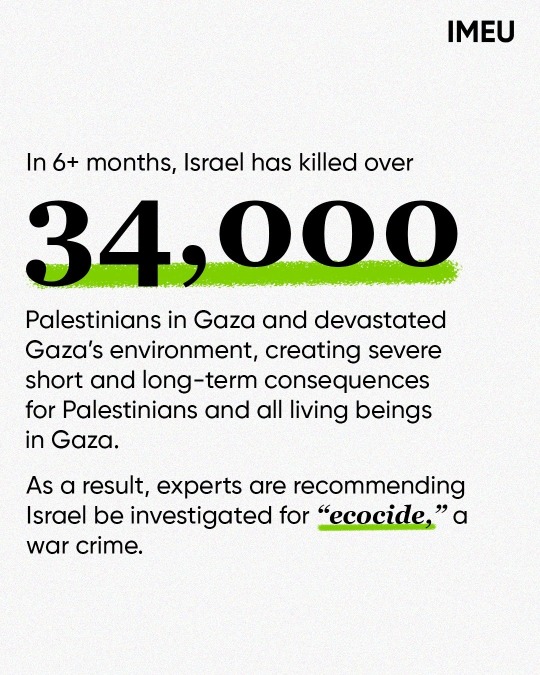
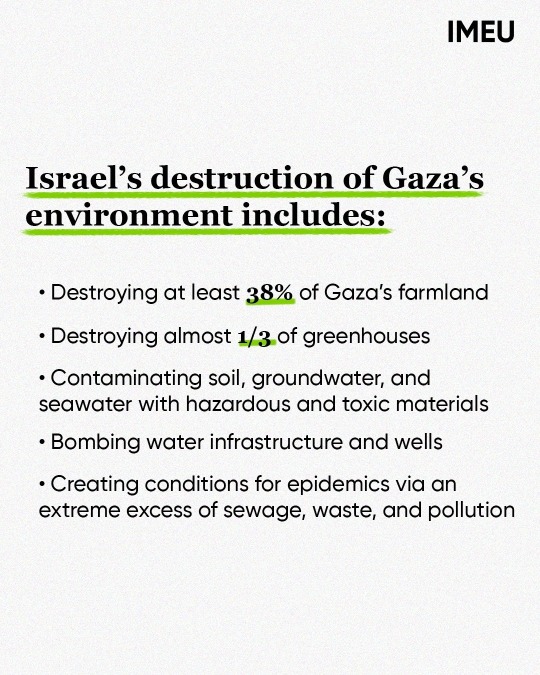



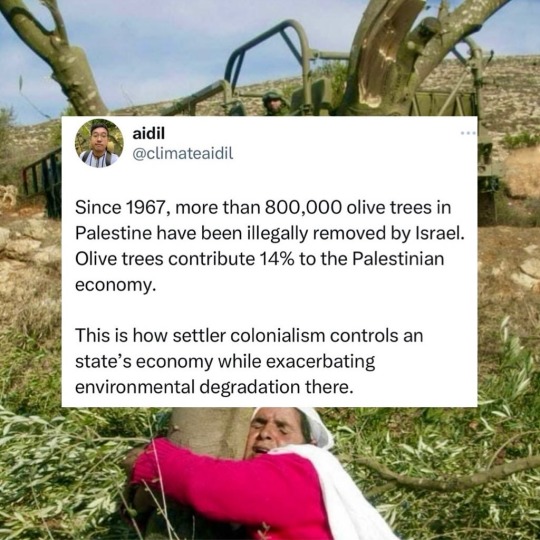

🌿An Earth Day fusion repost from @theimeu and @muchachafanzine.
🌿In honor of Earth Day, please visit @zaytoun_cic, @handmadepalestine, or @plant.eenolijfboom to plant an olive tree in Palestine. 🕊
🌿From @theimeu:
This Earth Day, we mourn the 34,000+ Palestinians killed by Israel in Gaza and Israel’s continued degradation of Gaza’s land, water, and other natural resources that make life possible for Palestinians.
In the past 6 months alone, Israel has destroyed farmland and greenhouses, contaminated natural resources with hazardous materials, bombed key water purifying infrastructure and wells, and created conditions for epidemics caused by an extreme excess of sewage, waste, and pollution.
Israel’s systematic destruction of Gaza’s environment is part of its goal of making life for Palestinians in Gaza unlivable.
Link in bio to contact your reps and urge an immediate, permanent ceasefire and the immediate suspension of all arms and funds to Israel.
Sources: The Guardian, Scientific American
🌿From @muchachafanzine:
Reminder this #EarthDay that from Turtle Island to Pa1estine, your environmentalism doesn’t mean sh!t if you don’t support giving the #LandBack to Indigenous people. 🤷🏽♀️
#land back#indigenous rights#indigenous resistance#indigenous peoples#human rights#palestine#free palestine#gaza#ecocide#ecology#environmental activism#environment#olive trees#free gaza#stop the genocide#earth day#natural resources#farming#land stewardship#israel#israel is committing genocide#israel is a terrorist state#israeli apartheid#israeli occupation#end the occupation#ceasefire now
70 notes
·
View notes
Text
Big Agro wants to override Lula on indigenous land rights issue
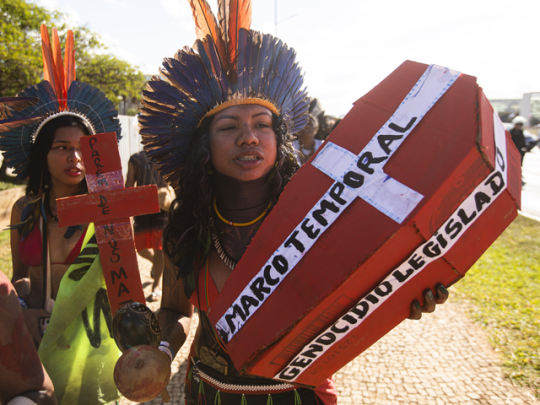
Lawmakers allied to Big Agro have pledged to override President Luiz Inácio Lula da Silva’s veto of a bill aiming to curtail the rights of indigenous peoples to their lands.
In recent years, Big Agro has defended the so-called “time-frame argument.” It seeks to define October 5, 1988 — the date the Brazilian Constitution was enacted — as the cut-off point for land rights. According to this understanding, if an indigenous group could not prove that it was occupying or contesting said land on that date, it would not have a territorial claim.
Indigenous leaders have rejected the time-frame argument because several communities were displaced from their lands while the Constitution was being drawn up.
Back in September, in a landmark decision, Supreme Court justices ruled 9-2 that the time-frame argument is unconstitutional.
Continue reading.
#brazil#brazilian politics#politics#environmental justice#indigenous rights#farming#mod nise da silveira#image description in alt
139 notes
·
View notes
Text
In response to last year’s record-breaking heat due to El Niño and impacts from climate change, Indigenous Zenù farmers in Colombia are trying to revive the cultivation of traditional climate-resilient seeds and agroecology systems.
One traditional farming system combines farming with fishing: locals fish during the rainy season when water levels are high, and farm during the dry season on the fertile soils left by the receding water.
Locals and ecologists say conflicts over land with surrounding plantation owners, cattle ranchers and mines are also worsening the impacts of the climate crisis.
To protect their land, the Zenù reserve, which is today surrounded by monoculture plantations, was in 2005 declared the first Colombian territory free from GMOs.
#good news#science#environmentalism#indigenous people#indigenous agriculture#zenù#agroecology#nature#environment#farming#sustainable farming#climate resilience#climate change#columbia
55 notes
·
View notes
Text

About the Campaign
The Aim:
We are seeking 30 acres of land with healthy soil, ideally with a previous history of agricultural use. The land should be within 20 miles of Denver, CO and grant us both water and mineral rights. The land should be valued equally to all members of the ecosystem that occupy it. We intend to use this land to grow food for our communities throughout Denver and as a place of education and healing. The land would be owned by the organization, FrontLine Farming, but would also be open to collective use in our BIPOC community.
Now is the Time:
Black, Brown and Indigenous Farmers across the United States have been systemically excluded from access to land whether through outright intimidation and theft, loan discrimination or laws such as Heirs Property Rights. Land in the United States was stolen from Indigenous Communities and while BIPOC communities represent a quarter of the US population, they own less than 5% of farmland and cultivate on less than 1% of the land. Yet those who have historically cultivated the land and comprise the over 2.4 million farmworkers in the United States are people of color from diverse communities and foodways. They are descendants of Africans brought here, immigrants, refugees and people who have continuously brought their agricultural knowledge and skills to feed nations.
We have used our radical imaginations for our vision of coming back to the land and are ready to bring this vision to life. To acquire our own soil and land will fortify our efforts to honor our ancestors, to educate our community, to generate independent economic systems, to manifest equitable policies and systems change, to lead by example, to understand history and to create our future. It is a way to co-create generational wealth for our communities, and more importantly, shared power.
Acquiring the land that we envision requires moving money and resources. We are seeking support from philanthropy, local and national networks, and donors. The funds raised from this project will aid our vision and goal.
Frontline Farming
We are a BIPOC-led farmer advocacy and food justice organization that strives to create greater equity across our food system on the Front Range of Colorado. We support and create greater leadership and access for Black, Indigenous, People of Color and Womxn in our food systems. We achieve these goals through growing food, listening, educating, honoring land and ancestors, generating policy initiatives and engaging in direct action.
In 2021, we distributed 26,000 lbs of farmed produce through various programs such as our CSA, Healing Foods and SNAP/WIC recipients. We also advocate for farmers and farm workers alike to ensure that the people who grow our country’s food have access to basic rights and protections that are already afforded to other workers in the state.
#bipoc#farming#indigenous#agriculture#food sovereignty#land back#native american#environmentalism#science#environment#nature#colorado#denver#usa
76 notes
·
View notes
Text
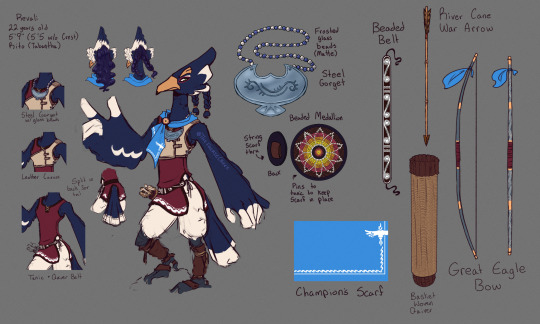
Continuing my series of botw redesigns, I'm working on my boyfriend Revali!
#i'm always nervous posting character designs#especially redesigns of canon characters#since the rito arent based on any specific indigenous american tribe#and theres lots of conflicting details#i decided to follow the heart of the cards and base it off the tribe i'm descended from#combining choctaw patterns with the fashion that's popular in Hyrule#his leather cuirass is based on the design of the cuirass in the hylian tunic#and also trying to take into account that his clothes should be designed with flight and archery in mind#putting the quiver within reach of his feet so he can shoot without using his wigns#and pinning his scarf with a sunburst medallion that pins to his tunic#i also opted not to include the red cheek spots. ✌️#i've been putting so much thought into the rito#like i want them to have more of a farming culture than they do in the game#farming grains and such#prevalent basket weavers and beaders#thefaeriecreekart#loz#project rewild#revali#botw#rewild revali#zelda fanart#anyway good chance this will be how i draw him from here on out-#look. i know totk has been out for months now. i know revalis gone. but i still love him i want him back
77 notes
·
View notes
Link
852 notes
·
View notes
Text
I called in sick today so I could muck around in the garden.
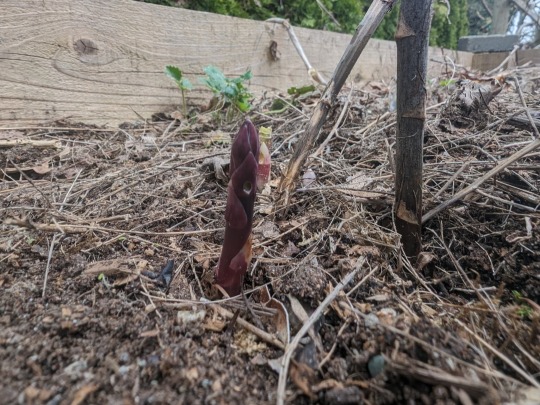
The sun came out at around 0900 and I like to think it was the universe telling me I made the right choice.
I found the first spears of asparagus pushing out of the ground. There were 3 fat fuzzy bumblebees going wild on pussywillow pollen. Last year's daikon and broccoli left seeds that are sprouting independently. I planted sitaw and cassoulet bean starts in the greenhouse. I staked the new cherry and pear tree branches so they'll grow en espalier. I told the 3 yr old peach tree that it's the prettiest princess in the yard and the ancient Asian pear that it was a fucking champion for having about 100 visible blossoms despite half its trunk rotting away. There was random garlic growing everywhere so I relocated them beside the strawberries for pest control and company. I apologized while viciously pruning the raspberries and swore at the asshole buttercups that keep invading the bee flower patch.
Now I'm finishing a negroni and eating leftover baked pasta. Self care is different for everyone. Mine looks like rolling around in dirt.
#home produce#i don't like to use homesteading#too much colonial baggage#and I come from a culture that had always grown their own food until the late 20th century shamed us away from that#anyway gardens are my happy place#indigenous farming techniques#permaculture#intercropping#solarpunk
24 notes
·
View notes
Text
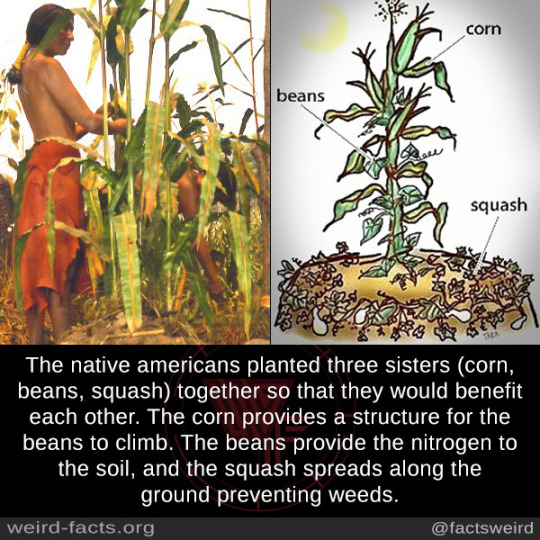
67 notes
·
View notes
Link
For humanity to progress towards a sustainable world with a secure food supply, the data now clearly show that we must change diets, reduce waste, diversify food systems — in existing or reduced agricultural land — and develop more-circular ways to produce food. It is also becoming apparent that ‘climate-smart’, environmentally sustainable food sources can come from underutilized plants and wild relatives of crop plants. Efforts to locate and manipulate such food sources should be guided by the communities who have long been using them, and who might be the main beneficiaries. (Most current work on crops largely entails mapping and editing genes and their functions in only a few dozen species.)
Bananas are one example. The seemingly incurable fungal infection Panama disease is affecting dense banana plantations across the tropics, posing a major threat to the global trade of bananas, which is currently dominated by the Cavendish variety. Yet the disease does not affect crops in Africa and southeast Asia, where Indigenous and local communities grow hundreds of varieties that are naturally resistant to it. In Uganda alone, nearly 100 varieties of banana contribute to the sustainable livelihoods of millions of people.
Likewise, the plant enset, also called the tree against hunger (Ensete ventricosum), is hardly known outside southwestern Ethiopia. But in this region, where it has probably grown for millennia, its starch-filled stems provide more than 20 million people with their main source of calories and nutrients. Its leaves are used to feed cattle, to provide shade and to build roofs; the stems provide fibres for basket-making; and when planted in rows, enset is used in place of fences to define land ownership and reduce conflicts. Perhaps most importantly in relation to climate change, enset is remarkably tolerant of drought and short-term temperature variations.
Almost 500 million Indigenous people, speaking at least 4,000 languages, occupy more than 25% of the global land surface. They often have the best ecological knowledge about the region they live in, and know which species are most important for their communities. They also hold taxonomic knowledge that has been neglected by scientists from elsewhere.
294 notes
·
View notes
Text
The earliest written accounts of life on the coast, from the late 1700s, often refer to this area as being an “untamed wilderness.” The coast did not look like an English Garden, or a European farm, nor did the cultivation of these lands stand out with obviously unnatural or artificial features but rather was molded closely with the local geography. These authors did not recognize a form of cultivation that was unfamiliar to them. To their unaccustomed eyes, the coast was wild. It was not.
A local example can be found at Mittlenatch Island. The small island looks rather unremarkable from the Campbell River shore; however, a closer inspection reveals just how intensely it was cultivated. Nearly all the “wild” flowers and shrubs are edible in some part, either their roots or their fruits. Some species, such as Camas, require regular harvesting and even controlled burning to increase its production.
43 notes
·
View notes
Text
Brazil launches biggest ever operation against illegal cattle farms in Amazon
Taskforce deployed to remove thousands of cows owned by land grabbers from indigenous territory

The Brazilian government has launched its biggest ever operation to remove thousands of cows owned by illegal land grabbers from indigenous territory in the Amazon rainforest.
Three helicopters, a dozen vehicles and a heavily armed corps of police and environment rangers are carrying out the cattle drive, which criminal gangs attempted to block by setting fires on the route, destroying bridges and intimidating drivers.
Operation Eraha Tapiro (“Ox Removal” in the language of the Assurini Indigenous people) aims to restore state control over the Ituna-Itatá Indigenous Territory, which suffered some of the worst deforestation and invasions in the Amazon during the previous presidency of the nationalist Jair Bolsonaro.
Since a change of power at the start of this year, the leftwing president, Luiz Inácio Lula da Silva, has promised to curb environmental crime, halt the expansion of the agricultural frontier and aim for zero deforestation by 2030. The environment minister, Marina Silva, has launched a series of operations to drive illegal miners and ranchers out of indigenous territory and other public lands that are under the protection of the state.
Continue reading.
#brazil#politics#brazilian politics#environmental justice#indigenous rights#farming#mod nise da silveira#image description in alt
80 notes
·
View notes